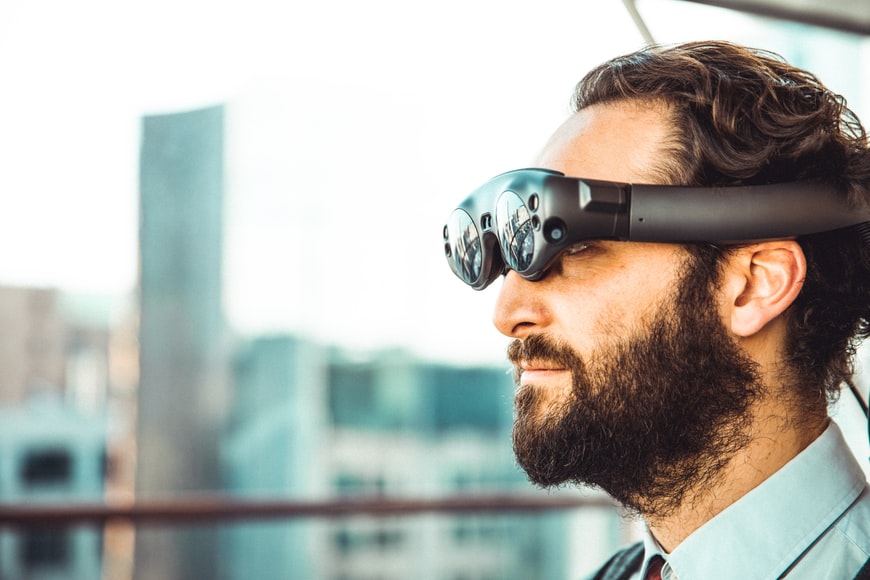Despite the growing popularity of augmented reality, many people are still confused about what it is. Moreover, they are unsure of how it genuinely enhances their experience.
Augmented Reality glasses have, for a long time, been a part of sci-fi wonder. The first time we saw these glasses closest to the modern-day smart glasses was in Back to the Future II (1989). In 2011, Google created the first smart glasses which were made publicly available in 2013. Although AR glasses did not take off as smartwatches, they are the next big thing in the wearable market.
AR glasses work by overlaying digital data onto real-world surroundings through smart-enabled glasses. This technology works similar to apps like Snapchat and Pokemon Go on a smartphone.
Looking for more details surrounding what AR glasses are and how they work? Let’s find out.
What are AR glasses?
Augmented Reality is a technology that enhances real-world objects with computer-generated sensory data. AR glasses utilize this technology to superimpose digital content on a wearable mobile device screen.
These glasses came in various sizes, shapes, and designs. However, they all have one thing in common; they enhance the real world with digital laminations.
You might want to improve your real-life experiences for several reasons.
For example, you may want to augment your football game-watching experience. Smart Glasses can help you see pertinent details and player scores. These glasses can also help you choose an ideal restaurant for dinner. This is done by displaying reviews and ratings as you walk by one.
How do AR glasses work?
AR glasses combine the features of a few key components to create the effects of adding objects to the real world.
Display
A combiner is the display of an AR smart glass. It is a combination of a glass lens and an OLED or LED display. This allows both natural light and computer-generated images to reach the eyes. Therefore, when you wear AR glasses you see images from dual sources – the real and the virtual world.
Camera
An AR glass cannot ‘see’ the world by itself. It requires a camera to do so. However, most smartglasses these days merely offer audio capabilities. This is because the camera may constantly record the people in its surroundings posing ethical and legal issues.
Registration
The registration consists of virtual markers or icons. The computer uses them to place an AR or a virtual object in the actual world. You may have used it in decor augmented applications. It helps you place decor items in your house and see how they look before you splurge.
Computer Vision
Here is where the computer combines the images from the camera with the images generated with registration. The result is what you see via the AR display.
Field of View
The view field of an AR glass decides whether you have an immersive experience or merely stare through swimming goggles. A normal human’s field of vision is 150 degrees vertically and 210 degrees horizontally. At present, the highest field of view available in a smart glass is 50 degrees.
Why is making good AR displays so hard?
As with any new technology, manufacturing good AR glasses comes with its own challenges. You might think that the only feature to look for in an AR glass is its field of vision and the sensors. However, several other parameters are important for the display, and none less relevant than the other.
The most popular option for AR displays is waveguides. They operate using the phenomenon of total internal reflection to form images. Yet, they have low optical efficiency. Therefore, they need strong projectors, which are quite complex to make.
The design parametric complicates things further.
Manufacturers can easily increase the field of view if you don’t mind a bulky eyepiece. A larger eye box requires a powerful light source, which is yet another design challenge.
A good display necessitates a higher brightness. Yet, none of the available smart glasses today fulfill that necessity. This is because it is challenging to perfectly calibrate display brightness and transparency (the amount of real-world light that reaches your eye).
Even if you compromise with the dimmer display, it will be significantly inefficient when you step outdoors.
Optical engineers are striving to create optical routes with the highest possible image quality without deteriorating image quality. However, for now, you might have to accept image distortions in AR displays in order to optimize other parameters.
What can you do with AR glasses?
The primary reason for the failure of Google glasses was the vagueness of its existence. Consumers were uncertain of what solutions it would provide them.
However, AR technology has evolved a lot over time. Smart Glasses offer a variety of applications like educational training and smart shopping. You can virtually compare products and get the product information.
AR advertising is another big thing today. Pepsico’s bus shelter ad is one of their most innovative advertisements to date. You may watch the video below.
What are the disadvantages of AR glasses?
The use cases of smart glasses may sound compelling to you. However, it is critical to understand the challenges.
Sometimes, it may become tiring for your eyes and brain to use AR glasses. Your mind may not instantly understand why an object that you viewed through the glasses disappeared suddenly. This burden of sight and perception is taxing.
Moreover, wearing AR smart glasses constantly will give you blurred vision, leading to migraines. Its symptoms are headaches, discomfort, and visual tiredness. You may also lose your sense of balance. As a result, you will be unable to undertake certain daily activities such as cooking and washing.
Like any other connected technology, malware attacks on AR smart glasses may result in an overlay of incorrect data. This is especially disastrous if you use AR technology to make online transactions or for smart shopping.
How can AR technology change over time?
AR technology will change tremendously over time. It may replace our smartphones, computers, and life as we know it today.
In the near future, you can expect social media platforms to add more AR filters and enhance the image quality using AR. It may also be used to train professionals like doctors to carry out critical surgery with precision. This will not only decrease training costs but also increase a professional’s efficiency and knowledge.
Virtual reality may be integrated with augmented reality drastically changing the way conferences are held. You will be able to attend a conference and talk face to face with your colleagues. All this without even stepping out of your home.
The automobile industry is yet another place where AR is set to rule in the future. Cars will have AR glasses as the windshield that will point out a probable hazard beforehand. It will significantly reduce the number of accidents.
Additionally, you may use it as a guide to give you a nice tour of any city you visit.
Besides, organizations are working on making AR technology more user-friendly. Its integration will be indistinguishable from regular glasses. The prices of the two may also be analogous.
Final Word
That’s all for this article. Hopefully, we covered everything on how AR glasses work. The future of augmented reality glasses is bright. Developers are working on overcoming the challenges in its manufacturing.
This article covers only a small part of its applications. AR has the potential for a lot more. If you want to learn about AR technology in more detail, there are several resources available online. Feel free to reach out if you have any questions.


